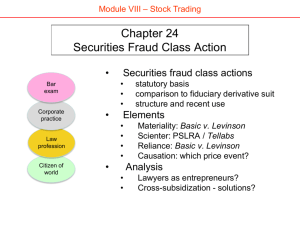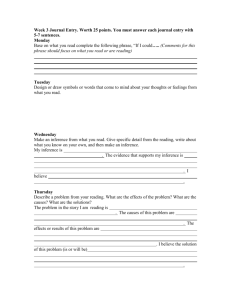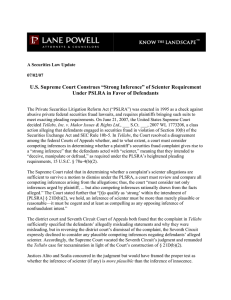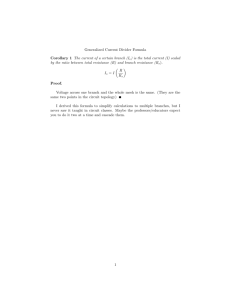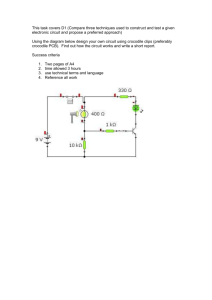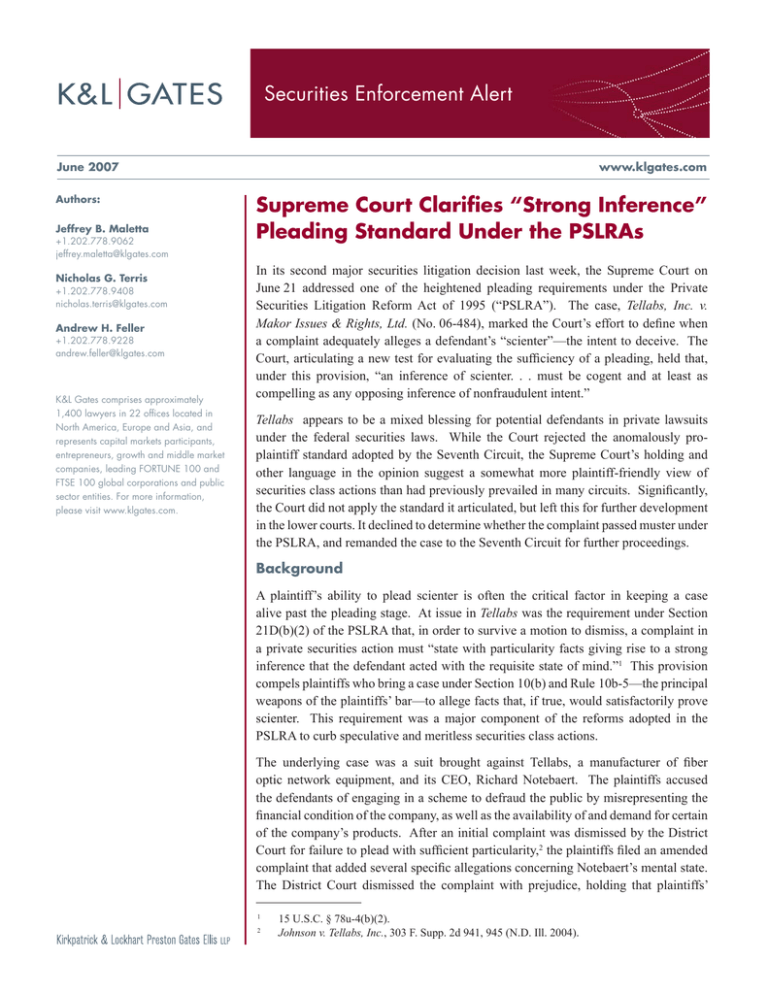
Securities Enforcement Alert
June 2007
Authors:
Jeffrey B. Maletta
+1.202.778.9062
jeffrey.maletta@klgates.com
Nicholas G. Terris
+1.202.778.9408
nicholas.terris@klgates.com
Andrew H. Feller
+1.202.778.9228
andrew.feller@klgates.com
K&L Gates comprises approximately
1,400 lawyers in 22 offices located in
North America, Europe and Asia, and
represents capital markets participants,
entrepreneurs, growth and middle market
companies, leading FORTUNE 100 and
FTSE 100 global corporations and public
sector entities. For more information,
please visit www.klgates.com.
www.klgates.com
Supreme Court Clarifies “Strong Inference”
Pleading Standard Under the PSLRAs
In its second major securities litigation decision last week, the Supreme Court on
June 21 addressed one of the heightened pleading requirements under the Private
Securities Litigation Reform Act of 1995 (“PSLRA”). The case, Tellabs, Inc. v.
Makor Issues & Rights, Ltd. (No. 06-484), marked the Court’s effort to define when
a complaint adequately alleges a defendant’s “scienter”—the intent to deceive. The
Court, articulating a new test for evaluating the sufficiency of a pleading, held that,
under this provision, “an inference of scienter. . . must be cogent and at least as
compelling as any opposing inference of nonfraudulent intent.”
Tellabs appears to be a mixed blessing for potential defendants in private lawsuits
under the federal securities laws. While the Court rejected the anomalously proplaintiff standard adopted by the Seventh Circuit, the Supreme Court’s holding and
other language in the opinion suggest a somewhat more plaintiff-friendly view of
securities class actions than had previously prevailed in many circuits. Significantly,
the Court did not apply the standard it articulated, but left this for further development
in the lower courts. It declined to determine whether the complaint passed muster under
the PSLRA, and remanded the case to the Seventh Circuit for further proceedings.
Background
A plaintiff’s ability to plead scienter is often the critical factor in keeping a case
alive past the pleading stage. At issue in Tellabs was the requirement under Section
21D(b)(2) of the PSLRA that, in order to survive a motion to dismiss, a complaint in
a private securities action must “state with particularity facts giving rise to a strong
inference that the defendant acted with the requisite state of mind.”1 This provision
compels plaintiffs who bring a case under Section 10(b) and Rule 10b-5—the principal
weapons of the plaintiffs’ bar—to allege facts that, if true, would satisfactorily prove
scienter. This requirement was a major component of the reforms adopted in the
PSLRA to curb speculative and meritless securities class actions.
The underlying case was a suit brought against Tellabs, a manufacturer of fiber
optic network equipment, and its CEO, Richard Notebaert. The plaintiffs accused
the defendants of engaging in a scheme to defraud the public by misrepresenting the
financial condition of the company, as well as the availability of and demand for certain
of the company’s products. After an initial complaint was dismissed by the District
Court for failure to plead with sufficient particularity,2 the plaintiffs filed an amended
complaint that added several specific allegations concerning Notebaert’s mental state.
The District Court dismissed the complaint with prejudice, holding that plaintiffs’
1
2
15 U.S.C. § 78u-4(b)(2).
Johnson v. Tellabs, Inc., 303 F. Supp. 2d 941, 945 (N.D. Ill. 2004).
Securities Enforcement Alert
allegations that Notebaert acted with scienter were
insufficient under the PSLRA.3
On appeal, the Seventh Circuit reversed, holding
that under the PSLRA, a complaint should survive
“if it alleges facts from which, if true, a reasonable
person could infer that the defendant acted with the
required intent”4 irrespective of the comparative
strength of other possible inferences. In so
holding, the Seventh Circuit explicitly rejected the
stricter standard used by the Sixth Circuit, which
requires that “plaintiffs are entitled only to the most
plausible of competing inferences.”5 The Supreme
Court granted certiorari in order “to resolve the
disagreement among the Circuits on whether, and
to what extent, a court must consider competing
inferences” in determining whether a complaint
satisfies the heightened pleading requirement of the
PSLRA.
The Supreme Court’s Rulings
The Supreme Court squarely rejected the Seventh
Circuit’s standard, and held that the PSLRA text
requires the weighing of competing inferences.
Writing for a six-justice majority, Justice Ginsburg
reiterated the Court’s stance “that private securities
litigation [i]s an indispensable tool” for defrauded
investors, but recognized that the PSLRA was
“[d]esigned to curb perceived abuses of the §10(b)
private action,” and that the heightened pleading
requirement was one of the means by which
Congress chose to do so. Therefore, she wrote, the
Seventh Circuit’s interpretation failed to “capture
the stricter demand Congress sought to convey in
§21D(b)(2).” Instead, “an inference of scienter
must be more than merely plausible or reasonable—
it must be cogent and at least as compelling as any
opposing inference of nonfraudulent intent.” The
Court described this new standard as satisfying “the
3
Id. at 971.
Makor Issues & Rights, Ltd. v. Tellabs, Inc., 437 F.3d
588, 602 (7th Cir. 2006).
5
Id. at 601, 602 (quoting Fidel v. Farley, 392 F.3d 220,
226 (6th Cir. 2004)).
4
PSLRA’s twin goals. . . [of] curb[ing] frivolous,
lawyer-driven litigation, while preserving investors’
ability to recover on meritorious claims.”
The Court described the required analysis under
the PSLRA as “inherently comparative,” and said
that in performing this analysis, courts “must
consider plausible nonculpable explanations for
the defendant’s conduct, as well as inferences
favoring the plaintiff.”6 The Court emphasized,
however, that in this comparison, the inference
that the defendant acted with scienter need not be
irrefutable, or a “smoking gun,” but rather must be
“cogent and compelling, [and] thus strong in light
of other explanations.” The Court was also explicit
in stating that under the new standard, a plaintiff
need not plead more than he would be required to
prove at trial, where the claim must be proved by “a
preponderance of the evidence.”
Importantly, in response to the defendant’s argument
that some of plaintiffs’ allegations were too vague
or ambiguous to contribute to a strong inference
of scienter, the Court stated that, while “omissions
and ambiguities count against inferring scienter,”
a court should not “scrutinize each allegation in
isolation,” but should instead endeavor to assess all
the allegations “holistically.”
The Court also made some potentially important
pronouncements about a defendant’s alleged
motive. Makor, in its complaint, did not allege that
Notebaert sold any stock during the class period.
Tellabs argued that the lack of allegation of motive
“color[ed] all the other allegations putatively giving
rise to an inference of scienter.” The Court agreed
that motive was a relevant consideration in assessing
inference of scienter, but stopped short of saying that
6
The Seventh Circuit also raised concerns that a
comparative inquiry would run afoul of the Seventh
Amendment right to a trial by jury. The Supreme Court
rejected this contention, noting that Congress, as creator of
federal statutory claims, has the power to determine what
must be pleaded to state a claim, in addition to the power to
determine what must be proved to prevail on the merits.
June 2007 | 2
Securities Enforcement Alert
allegations of motive are essential to establishing
that inference. Rather, the Court agreed with the
Seventh Circuit that while “personal financial gain
may weigh heavily in favor of a scienter inference,
. . .absence of a motive allegation is not fatal” to a
complaint.
Justices Scalia and Alito, writing in separate
concurrences, advocated a tougher test than that
adopted by the Court. Both opined that, under
a plain reading of the language of the PSLRA’s
pleading requirement, the test should be “whether
the inference of scienter. . . is more plausible than
the inference of innocence.” (emphasis in original).
Justice Alito additionally rejected the holistic
approach to pleadings, objecting to the Court’s
apparent willingness to consider any individual
scienter allegation that failed, on its own, to meet
the PSLRA’s particularity requirements. Justice
Stevens offered the only dissent, proposing a
“probable cause” standard, and disagreeing with
the Court’s requirement of a comparative analysis
of competing inferences.
Comparison With Prior Law
While any effort to definitively assess Tellabs’
impact is plainly premature, some tentative
comparisons with prior law are worth attempting.
Although the Supreme Court has now made clear
that the floor for PSLRA pleading standards is above
that established by the Seventh Circuit in its outlier
opinion, the Court’s language and holding also
suggest that the ceiling on these pleading standards
is somewhat below that suggested by some prior
circuit opinions. In particular:
To the extent that the Court’s newly articulated
“cogent and at least as compelling” standard
indicates that “the tie goes to the plaintiff,” it
is substantially similar to the standard of only
one other circuit that has previously ruled on
this issue.7 It appears to be a rejection of the
7
See Pirraglia v. Novell, Inc., 339 F.3d 1182, 1188 (10th
Cir. 2003). In addition, the Eighth Circuit appears to have
implicitly adopted a similar standard. See In re K-tel Int’l,
Inc. Sec. Litig., 300 F.3d 881, 889 n.6 (8th Cir. 2002).
standards adopted by at least four other circuits,
which required that the inference of scienter be
stronger than competing inferences suggesting
nonculpable behavior.8
The Court’s willingness to at least give
some consideration (however slight) to nonparticularized allegations of scienter also may
signify a break with the rule in at least one
circuit. See, e.g., California Public Employees’
Retirement Sys. v. Chubb Corp., 394 F.3d
126, 145 (3d Cir. 2004) (“unless plaintiffs in
securities fraud actions allege facts supporting
their contentions of fraud with the requisite
particularity … they may not benefit from
inferences flowing from vague or unspecific
allegations – inferences that may arguably have
been justified under a traditional Rule 12(b)(6)
analysis” ) (citations and internal quotation
marks omitted).
The precise import of the Court’s statement
that “personal financial gain may weigh
heavily in favor of a scienter inference” is not
yet clear. The suggestion that such so-called
motive allegations may be entitled to “heav[y]”
weight may provide a slight boost to plaintiffs
in some circuits. Compare with, e.g., Florida
State Board of Admin v. Green Tree Financial
Corp., 270 F.3d 645, 660 (8th Cir. 2001)
(describing motive and opportunity allegations
as “generally relevant to a fraud case” and a
showing of “unusual or heightened motive will
often form an important part of a [sufficient]
complaint”). But the Supreme Court stopped
short of endorsing language in some Second and
Third Circuit opinions suggesting that motive
8
See Helwig v. Vencor, Inc., 251 F.3d 540, 553 (6th Cir.
2001) (“plaintiffs are entitled only to the most plausible of
competing inferences”); In re Credit Suisse First Boston
Corp., 431 F.3d 36, 49 (1st Cir. 2005) (allegations insufficient
when “there are legitimate explanations for the behavior
that are equally convincing”); Gompper v. VISX, Inc., 298
F.3d 893, 897 (9th Cir. 2002); Ottman v. Hanger Orthopedic
Group, Inc., 353 F.3d 338, 350 (4th Cir. 2003) (both holding
that complaint is insufficient if “it is equally if not more
plausible” that plaintiff’s conduct was nonculpable).
June 2007 | 3
Securities Enforcement Alert
allegations can be independently sufficient to
satisfy the PSLRA pleading requirements.
Concededly, as Justice Scalia recognized in his
concurrence, potential distinctions such as these
may make little difference in practice. Indeed,
when it comes to securities litigation pleading
standards, the devil is in the details. What often
matters most is how the standards are applied given
the relatively slight differences among the standards
themselves and the highly fact intensive nature of
judicial assessment of a specific complaint. See
generally Phillips, Maletta & Terris, “Securities
Litigation” in Business and Commercial Litigation
in the Federal Courts (2d ed. 2005) § 62:45 at 987.
Thus, while Ninth Circuit cases are often regarded
as having articulated the most pro-defendant preTellabs pleading standard, courts in that circuit are
perhaps the least likely to grant motions to dismiss.
Id.
Another potentially more significant case is waiting
in the wings. This fall, the Court hears arguments in
Stoneridge Investment Partners, LLC v. ScientificAtlanta, Inc., which concerns the question of
whether and to what extent “secondary” actors
such as accountants, lawyers and underwriters
of securities offerings may be liable as primary
violators of Section 10(b) and Rule 10b-5. These
potential deep-pocket defendants often have been
protected by the Supreme Court’s 1994 Central
Bank decision, which held that there was no private
right of action under Section 10(b) and Rule 10b-5
for aiding and abetting violations of the securities
laws.9
For more information on Tellabs, Stoneridge, or any
of the issues discussed in this Alert, please contact
one of the authors listed on the first page.
Conclusion
The impact of Tellabs on private securities litigation
is difficult to predict, for the decision sends
some mixed signals, and leaves important issues
—especially how the standard is to be applied—
unaddressed.
9
Central Bank of Denver, N.A. v. First Interstate Bank of
Denver, N.A., 511 U.S. 164 (1994).
K&L Gates comprises multiple affiliated partnerships: a limited liability partnership with the full name Kirkpatrick & Lockhart Preston Gates Ellis
LLP qualified in Delaware and maintaining offices throughout the U.S., in Berlin, and in Beijing (Kirkpatrick & Lockhart Preston Gates Ellis LLP
Beijing Representative Office); a limited liability partnership (also named Kirkpatrick & Lockhart Preston Gates Ellis LLP) incorporated in England
and maintaining our London office; a Taiwan general partnership (Kirkpatrick & Lockhart Preston Gates Ellis) which practices from our Taipei
office; and a Hong Kong general partnership (Kirkpatrick & Lockhart Preston Gates Ellis, Solicitors) which practices from our Hong Kong office.
K&L Gates maintains appropriate registrations in the jurisdictions in which its offices are located. A list of the partners in each entity is available
for inspection at any K&L Gates office.
This publication/newsletter is for informational purposes and does not contain or convey legal advice. The information herein should not be used
or relied upon in regard to any particular facts or circumstances without first consulting a lawyer.
Data Protection Act 1998—We may contact you from time to time with information on Kirkpatrick & Lockhart Preston Gates Ellis LLP seminars
and with our regular newsletters, which may be of interest to you. We will not provide your details to any third parties. Please e-mail london@
klgates.com if you would prefer not to receive this information.
©1996-2007 Kirkpatrick & Lockhart Preston Gates Ellis LLP. All Rights Reserved.
June 2007 | 4

